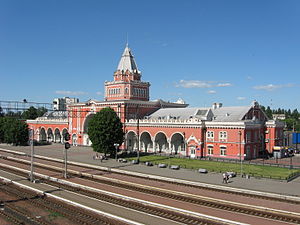Chernihiv–Ovruch railway
| Chernihiv–Ovruch railway | |
|---|---|

Chernihiv station building and platforms
|
|
| Overview | |
| Native name | Ukrainian: Дільниця Чернігів–Овруч Russian: Участок Чернигов–Овруч Belarusian: Ўчастак Чарнігаў–Оўруч |
| Type | Commuter rail |
| Status | Partially active (84,4 km) |
| Locale | Ukraine, Belarus |
| Termini |
Chernihiv, Ukraine Ovruch, Ukraine |
| Operation | |
| Opened | 1930 |
| Owner | Ukrainian Railways (UZ) |
| Operator(s) | Southwestern Railways (PZZ) |
| Technical | |
| Line length | 177.5 km (110.3 mi) |
| Track gauge | 1,520 mm (4 ft 11 27⁄32 in) (Russian) |
| Electrification | 25 kV 50 Hz AC (84,4 km) |
The Chernihiv–Ovruch railway is a partially electrified and partially operational single track rail that stretches between the town of Ovruch and the city of Chernihiv, in northern Ukraine, passing through southern Belarus and the Chernobyl Exclusion Zone. The line is owned by Ukrzaliznytsia alone with train stations located in Belarus being leased from the government of Belarus. The portion of the road between train stations Vilcha and Semykhody is not in service since the time of Chernobyl disaster (24 April 1986).
Line's construction started in 1928, as part of modernization and development program of the Southwestern Railways (Ukrainian: Південно-Західна залізниця). It was opened, for passenger traffic, in 1930. Partially abandoned after the Chernobyl disaster of 1986, it works in its eastern section, between Chernihiv and Semikhody, a terminus station near Pripyat serving the Chernobyl Nuclear Power Plant. This line section was electrified in 1988.
The line starts at the central station of Chernihiv, capital of the homonym oblast, located on Minsk-Gomel-Kiev line. After 2 minor stops within the city, it passes through some villages of Chernihiv Raion. At Zhukotky station started a (now closed) branch to Karkhivka and Zhydinychi. 36 km after Chernihiv the line reaches Slavutych, a city built in 1986 for the refugees from Pripyat and Chernobyl. Its station replaced the pre-existing "Nerafa", demolished to build a larger station for the new city.
...
Wikipedia
